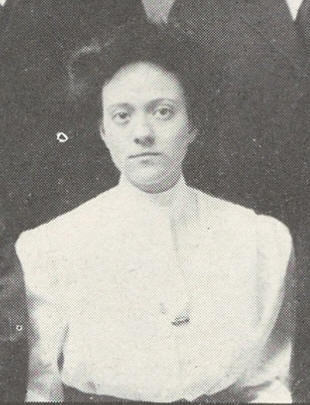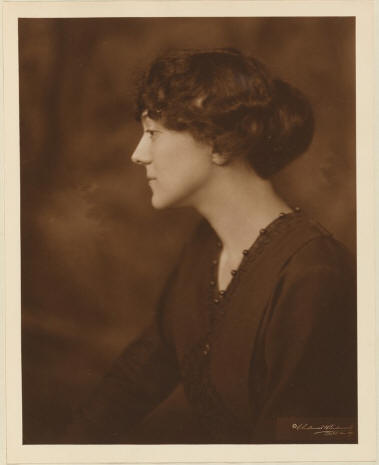

Queer Places:
Cornell University (Ivy League), 410 Thurston Ave, Ithaca, NY 14850
304 Stewart Ave, Ithaca, NY 14850
160 Waverly Pl, New York, NY 10014
142 W 18th St, New York, NY 10011
 Elizabeth Ellsworth Cook (September
4, 1884 - 1981)
was a pacifist, suffragist, and businesswoman. She was a member of the
Heterodoxy Club.
Elizabeth Ellsworth Cook (September
4, 1884 - 1981)
was a pacifist, suffragist, and businesswoman. She was a member of the
Heterodoxy Club.
Cook was born in Winona, Minnesota, the daughter of Charles Button Cook and Lucy Hawley Ellsworth (1861-1931). She was the granddaughter of Judge Perry G. Ellsworth. Her sisters were Fayette A. Cook and Laura Ellsworth Cook Seiler. She attended public schools in Ithaca, N.Y., and graduated from Cornell University (A.B. 1908). She was a member of Phi Beta Kappa honorary society. She was in the Intercollegiate debate team and won the Woodford prize for oratory ($100 in gold) in April 1908 in a suffrage speech over five competitors, all men. Columbia University had objected at the presence of a woman in the debate team of Cornell. At Cornell, she was friend with Nora Stanton Blatch (1883-1971), the granddaughter of Elizabeth Cady Stanton and daughter of Harriot Stanton Blatch, and the first woman in the U.S. to receive a degree in civil engineering. Later Cook's sister, Laura, said "I can remember Nora coming to dinner and much discussion of suffrage and so forth and so on. So, it was no surprise when my sister graduated that she should take a very active part in suffrage in New York."

From 1905 to 1907 she was the secretary to Edward T. Perine, ex-head of the Audit Co. of New York.
In 1908 she entered the banking house Harris, Forbes, and Co. as a statistician.
In 1909, as secretary of the Equality League of Self Supporting Women in New York, Cook replied to the request to railroad companies for special cars for women, that the demand for such cars seemed to imply that men were not courteous to women in the subway crowds. She repudiated such idea and thought the danger from accident would be even greater with women crowding women. She said that self-supporting women more than any others who travelled in rush crowds did not care ear for any lady's boudoir Jim Crow cars. Apparently Cook not only thought she could get along where there were men, but there was a strong intimation that she liked it.
The founder and President of the Equality League of Self Supporting Women was Harriot Stanton Blatch; other members included S. Frances Herzog, Martha Ornstein, Jessie Ashley, Gertrude Barnum. Madeline Z. Doty, Nora Stanton Blatch, L. L. Dock, Charlotte Perkins Gilman, Clara Ghymes, Adelaide B. Hyde, Florence Kelley, Vida Milholland, Mary Murphy, Leonora O'Reilly, Bertha Rembaugh, Sarah Field Splint, Marion Townsend, Florence Reuhand and Alberta M. Hill.
In 1910 she said that women refused to live on their father and in the future they would refuse to live on their husbands. It was so much more sensible from a purely financial standpoint for a woman earning anywhere from $15 a week to keep on with her work after marriage and hire really competent domestic service even if she paid for this altogether from her own salary.
In 1911 she partecipated to a march for women's suffrage in New York City with other 3000 women and at the end of it was among the orators talking to the crowd from stands or automobiles.
In 1912, together with Caroline Lexow Babcock and Dora Hazard, Cook organized the Rockland Branch of the Women's Political Union, of which she was a vice-president.
In 1913 women had the right to act as watchers at the polls. Elizabeth Ellsworth Cook watched so sharply on the Bowery that sixty men were challenged and several men convicted. The privilege was rescinded by the next Legislature.
In 1916 became a sales manager for Hemphill, Noyes, and Co., an investment securities firm. In 1917 she said that because women more and more were assuming the management of their own incomes, financial houses were going after them to invest in stocks and bonds and were employing women to sell bonds and stocks. Cook declared that there was such a scarcity of young college men willing to being at the bottom of the ladder in banks and financial institutions at $9 a week that college girls were received most cordially as substitutes, and were making good.
In 1917 she was included in the "Who's Who And Why" of the Saturday Evening Post, which depicted "serious and frivolous facts about the great and the near great." She said "If you think, dear Editor, that these plain facts about myself will help some young person hesitating at the foot of Wall Street, all right; otherwise they- certainly have no claim to ink and good white paper. My work is to sell investment bonds by letter. You'd be surprised what poor correspondents most prospective bond buyers are worse than boys at boarding school and I write them so faithfully and try so hard to make "safety of principal" alluring! Nevertheless, by plugging along at it all the time I managed to place as much my way as most salesmen do by personal interviews. How did I prepare for this rather specialized work? Partly by studying finance, economics and business law while at Cornell University, but chiefly by just trying till I could do it. I began as statistician for a large bond house, but as quickly as possible migrated to the sales department. I just had to. I'm no scholar. The statistics bored me to tears, but there is no sport I've ever tried equal to the fun of pushing a new issue. The fun is the test of it all. Financial selling has to be done fast, so accurately, so much on the alert for every changing phase of the stock market, the money market, the war news, that if it doesn't thrill you to your finger tips you had better look farther for the work that does. And you, my young friend, if the sound of the ticker lures you, spend a summer in a bond house and see what it is like. Then perhaps I can tell you enough more to help you decide whether to stay with the bond crowd or not."
In 1922 she was chairman of the Women's Peace Union of the Western Hemisphere. She was also a prominent speaker for the international "No More War" demonstration of New York City.
She was the first president of the Women's Bond Club and a member of the Municipal Forum and Municipal Analysts, both of New York.
In 1926 he Associated press included Cook among the 80 women prominent in New York's financial world.
Cook also served as director of Haffner Associates, a fabric manufacturer (1935-1955) and president of Direct Shipping Corporation (1935-1954), which grew and shipped produce from Florida.
She was part of the Heterodoxy club, a feminist debating group in Greenwich Village, New York City, in the early 20th century. The membership also included bisexual and lesbian women, in addition to heterosexuals.
Cook didn't retire from Wall Street till she was an old lady. She still had her own clients in a brokerage house until she was 84 in 1968. After that she moved to Florida.
My published books: